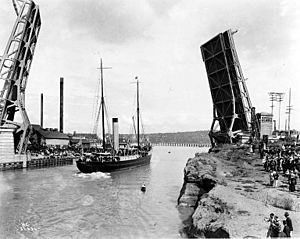Fremont Bridge (Seattle) facts for kids
Quick facts for kids Fremont Bridge |
|
|---|---|

The Fremont Bridge from the George Washington Memorial Bridge
|
|
| Carries | Fremont Avenue N |
| Crosses | Fremont Cut |
| Locale | Seattle, Washington |
| Maintained by | Washington State DOT |
| Characteristics | |
| Design | bascule |
| Total length | 502 feet (153 m) |
| Longest span | 242 feet (74 m) |
| Clearance below | 30 feet (9.1 m) |
| History | |
| Opened | June 15, 1917 |
| Designated: | December 28, 1981 |
|
Fremont Bridge
|
|
| Location | Spans Lake Washington Ship Canal, Seattle, Washington |
| Area | less than one acre |
| Built | 1917 |
| Engineer | Arthur H. Dimock |
| MPS | Historic Bridges/Tunnels in Washington State TR |
| NRHP reference No. | 82004234 |
| Added to NRHP | July 16, 1982 |

The Fremont Bridge is a special kind of bridge in Seattle, Washington. It's a bascule bridge, which means it can open up to let boats pass underneath. This bridge crosses the Fremont Cut, which is part of the Lake Washington Ship Canal. It connects the neighborhoods of Fremont and Queen Anne.
The Fremont Bridge first opened on June 15, 1917. It cost $410,000 to build. The very first vehicles to cross it were "owl cars," which were the last trolley runs of the day. After 5 AM, all other traffic could use the bridge. The Lake Washington Ship Canal was officially opened a little later, on July 4, 1917. This sometimes makes people confused about the bridge's actual opening date.
The Fremont Bridge was the first of four similar bridges built by the city to cross the canal. The others are the Ballard Bridge (1917), University Bridge (1919), and Montlake Bridge (1925). In 1982, the Fremont Bridge was added to the National Register of Historic Places. It is also a special city landmark.
A Bridge That's Always Busy
Before the Aurora Bridge was built in 1932, the Fremont Bridge was the busiest bascule bridge in the United States. It had more vehicle traffic than any other bridge of its kind. Even today, it's still one of the busiest.
The Fremont Bridge is quite low, only about 30 feet (9 meters) above the water. Because of this, it has to open very often to let taller boats pass. On average, it opens about 35 times a day! This makes it the most frequently opened drawbridge in the United States. It's also one of the busiest bascule bridges in the entire world.
Did you know that federal law says boats have the right-of-way over cars? This means the bridge usually opens for boats first. However, during busy rush hour times, the Fremont Bridge stays closed to most boat traffic to help cars get where they need to go.
Colors and Upgrades
When it was first built, the Fremont Bridge was painted a plain, dull green color. But in 1972, the Fremont Improvement Committee decided it needed a change. They picked a new color called "Fremont Orange." The people living in the area loved the idea!
Later, in 1985, the bridge got another new look. At a street fair, people voted for the bridge's current blue and orange colors.
In 2006, the Fremont Bridge got a big upgrade that cost $41.9 million. This project replaced parts of the bridge where cars drive on and fixed the maintenance shop. They also updated the electrical and mechanical systems that make the bridge open and close. The main work was finished by May 2007, and testing continued into 2008. In 2014, the city started repainting the bridge again.
In February 2018, the bridge received a cool new art installation. This was part of a special program celebrating the bridge's 100th birthday. The Fremont Bridge was given dynamic lighting, which means the lights can change! The plan is for the Ballard Bridge and University Bridge to get similar lighting if there's enough money.
Earlier Bridges at This Spot
The Fremont Bridge you see today is actually the third bridge built in this exact location.
- The first bridge was a low wooden bridge built around 1890 or 1891.
- In 1911, a taller wooden bridge replaced it. This was done because people knew the Lake Washington Ship Canal was going to be built soon. This second bridge was only meant to be temporary.
It turned out to be even more temporary than planned! On March 12, 1914, a dam called the Fremont dam broke. This dam controlled the water level of Lake Union. Over one day, the lake level dropped by nine feet! This left boats stuck and floating homes stranded. It also broke the middle part of the second Fremont bridge. Another nearby bridge, the Stone Avenue Bridge, stayed intact. Streetcars that used to cross the Fremont Bridge had to use the Stone Avenue Bridge until the current Fremont Bridge was finished.

